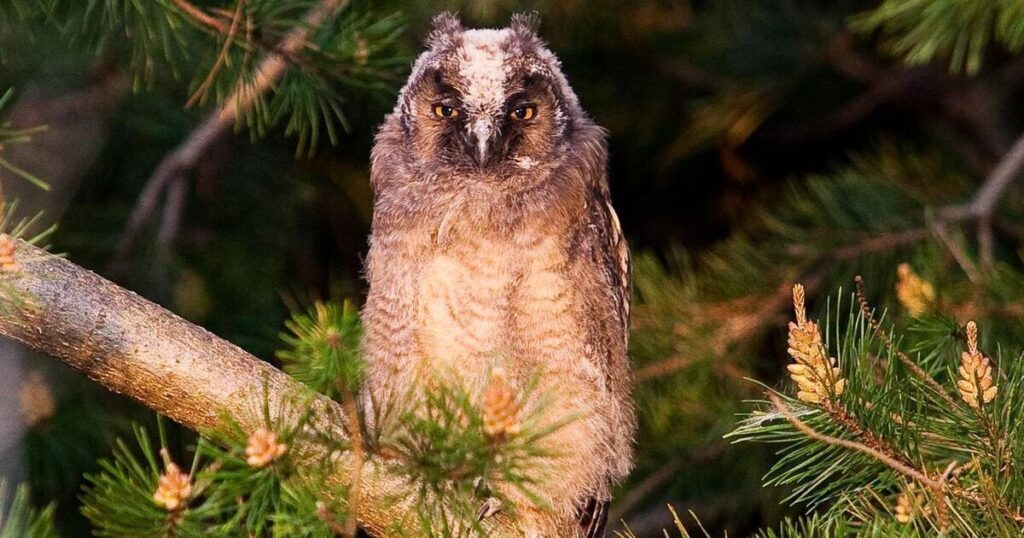Sounds set the scene of our surrounds and provide evidence about what creatures are close by. On summer days, crickets’ rhythmic trilling stridulations let us know that the long grass is full of life. Swifts screech loudly overhead, alerting us to their presence as they sweep up flying insects from the skies above.
Distinctive calls are how we recognise what wild animals are going about their lives in parallel to ours, perhaps seeking out a mate, claiming nesting territory, or warning their peers about the presence of an intruder. As the summer rolls on, mating and territorial calls have abated. Instead, we hear juveniles calling out to their parents for food. I’ve been listening to a fledgling blackbird perching on the roof of the little garden shed, sheltered by overgrowing ivy. Every few minutes this endearing fluffy youngster chirps a gurgling call, and within moments, their parent is placing food in their gaping yellow beak.
A similar dynamic applies across the world of birds right now, as youngsters of many species are near fully grown, learning the skills necessary for survival, yet still being fed by their parents. One of the most distinctive sounds of such fledgling callers comes from young owls, otherwise known as owlets. They don’t go ‘Tu-whit, To-who’, the owl call that we are incorrectly taught as children that all owls make. That’s the call of the tawny owl, a species found in England and Wales, but not in Ireland. With more than 200 species of owl in existence across the world, just barn owls and long-eared owls are native here.
Both are generally quiet through the year. It is only during the summer months that the call of young owlets lets us know we might have long eared owls as neighbours. Young ones born early in spring have grown big, though are as yet unable to master the sleuth required to hone in on a mouse from afar or the dexterity to catch it in their talons.
Long-eared owls’ distinctive squeaky call, which people often liken to the sound of a squeaky gate, is how we can tell that there are long-eared owls in the neighbourhood. It is a sound that carries well over distances, so parents out on nocturnal hunts are sure to hear it.
Often one can live amongst owls, never actually seeing them, though attuned to their presence from sound alone. By daytime, they perch discreetly in the branches of a tall tree. When dusk transforms the landscape, this is the cue for owls to come out and hunt, finding and catching voles, mice, and small birds with ease. A pair of owls feeding a brood of owlets can catch as many as 1,000 mice over the course of a summer.
Being top predators, owls have both excellent hearing and sight. Long eared owls’ eyes are enormous and bright orange, piercing through their pale brown disk of facial feathers. They have a higher proportion of rods than cones in their retina, which allows them so see far better in the dark than day-flying birds or mammals such as ourselves. Their iris is able to open almost completely, allowing even the faintest bit of light to reach the photoreceptive rods in the retina. Like when we look through binoculars, their field of vision is small, but allows them to see excellent detail in the distance. This is how owls can hone in on prey from afar, even at night. Their feathers are engineered to muffle the sound of their wingbeats, so they can swoop in silently and take prey by surprise.
All this silence and discretion is the reason why we can live with owls as neighbours, but never know it, unless we listen out carefully for the youngsters calling out at dusk during late summer. It is possible they will return to the nest site next year, as long-eared owls can live for as long as 10 years, and tend to nest in the same area year after year.
If you happen to see one, long eared owls are recognisable by their large ear tufts — feathers that stand up on their head where you might imagine their ears should be. But these ear tufts are not ears at all, they don’t even have a role in hearing. Instead, ear holes in the side of their head are positioned asymmetrically, allowing them to triangulate the precise location where a sound is coming from, accurately enough to guide them to a scuffling mouse in the undergrowth even in near total darkness. Hedgerows and woodlands with suitably mature trees are their favoured habitats, where they often adapt an old crow’s nest for themselves.
Long-eared owls are widespread and present in every county in Ireland, and while they go about their lives unnoticed by us, they are not at all an uncommon bird. The main pressure on their kind is the common use of rodenticides to control rats and mice, which then builds up in the owls, poisoning them slowly and impairing their ability to hunt. A build-up of poison in their system also makes owls vulnerable to collisions with road traffic.
As creatures of the night, owls of every species, right across the globe, have long been associated with darkness, death and wisdom. Athena, the ancient Greek warrior goddess, who had the power to see in the dark, was often depicted with an owl. Having the ability to see in the dark, to sense what moves about unseen, these are admirable traits. Wisdom is the ability to see what others cannot. And in a world so full of darkness and noise, tuning in to owls might be just what we’re after.


